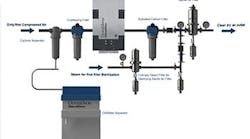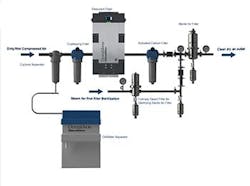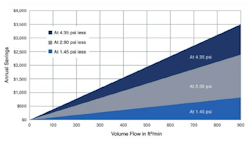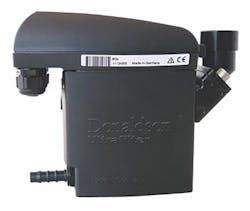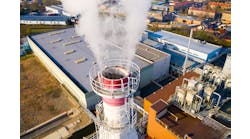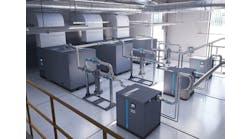6 Tips To Effectively Remove Contaminants From Compressed Air
Virtually every industrial chemical process requires compressed air. It is used to texturize products, dry sterilized equipment, form containers, move ingredients through lines, and serve as protective blankets around product stored in tanks. As essential as it is, compressed air also can be a prime source of contamination.
This problem is addressed by standards for clean, dry air — chiefly the International Organization for Standardization’s ISO 8573-1, which defines contaminants and specifies a range of purity classes for particular processes. Meeting this standard requires careful treatment and filtration.
First, it’s important to identify the probable contaminants in your facility. The impurity most prevalent in compressed air systems usually isn’t rust or dirt, although equipment can shed solid particulates. The greater risk is liquid — a combination of condensate that forms as compressed air cools and lubricants that leach from oil-flooded compressors, which are the most common units at plants. Moisture itself is a threat, of course, but a water/oil mixture also is an ideal organic diet for bacteria, which multiply quickly in the warm crevices of compressed air lines.
Thus, keeping air dry and oil-free is critical to product quality and safety. This typically requires a series or “train” of filters and dryers. Although each facility is unique, appropriate treatment usually involves prefiltration in the utility room as well as point-of-use filtration before compressed air contacts a product.
Figure 1. Proper treatment typically requires a train consisting of filters, dryers and separators.
Prefiltration in the utility room usually calls for:
• a coalescing filter (1–5 µm) to remove oil and protect the refrigerated dryer;
• a refrigerated dryer to condense and remove water content;
• a cyclone separator to mechanically drain remaining liquid condensate; and
• a coalescing filter (1–5 µm) to eliminate aerosols.
Point-of-use filtration before compressed air contacts a product typically requires:
• an adsorption dryer to remove water vapor; and
• point-of-use filters (0.2 µm) to take out contaminants potentially picked up in system lines.
Filtration removes a surprising volume of oily water from compressed air. At room temperature, a filtration system designed to handle air traveling at 500 std. ft3/min from an air compressor operating at 100 psi will might handle about 30 gallons of condensed water every 8 hours, notes the “Compressed Air and Gas Handbook.” This volume varies from one climate to another and fluctuates daily with temperature and humidity changes around a plant.
Common Myths
Managing moisture content and contamination while keeping compressed air from leaking is a challenge in filtration. Unfortunately, six common myths often undermine efforts. So, let’s look at them as well as tips for better results.
Myth 1 — The smaller the micron size the better. Truth: Focus on actual contaminants.
Carefully examine technical data sheets before selecting a filter. Not all filter manufacturers observe industry standards and their micron rating can give a misleading sense of filter performance. For instance, filters labeled 99.999% effective at an extremely small particle size, such as 0.01 µm, can seem impressive. However, that particulate size, which is 5,000 times smaller than the diameter of a human hair, actually is easier to catch than a 0.1-µm particle. More importantly, it’s too small to be of any practical significance as a contaminant.
Instead, pay attention to actual contamination threats in your compressed air system and the micron sizes they represent. Aerosolized oil, for example, ranges from approximately 0.1 to 1.0 µm, depending on turbulence from elbows and bends in a system. Use the purity classes in ISO 8573-1 as a point of reference and specify filters validated for efficiency at the particle sizes of interest.
Also, look for equipment verified by a third party using internationally accepted filter test methods. For example, the Institute of Energy and Environmental Technology in Germany validates Donaldson filters using test method ISO 12500 to measure the removal of aerosols, vapors, water and particulates.
Myth 2 — All pressure drop data are equally valid. Tip: Insist on filters tested in a wet condition.
Because of higher pressure drop, it takes more energy to push compressed air through a restrictive filter. This is why it’s important to specify filters tested in a wet condition. Compressed air filters remove water and oil aerosols, creating a liquid surface tension that restricts airflow. Reputable filter manufacturers will report wet pressure drop performance — the test method specified by ISO testing standards — on their technical data sheets. All else being equal, a higher performing filter will have a lower wet pressure drop.
Myth 3 — Filter media composition doesn’t matter. Tip: Hydrophobic/oleophobic media can lower operating costs.
Cheap filters may appeal to the cost conscious. However, if their media is restrictive, they can make a compressor work harder, consuming energy that outweighs their lower price.
On just one filter designed for airflow of 1,000 ft3/min, every additional psi of pressure to overcome restrictions adds energy costs of more than $1,000/yr (based on an estimate of 8,000 hr/yr at 10¢/kWh). Over a ten-year system life, extra energy costs for one filter could add up to $10,000 due to airflow restrictions over the life of the installation (Figure 2).
Figure 2. Even a modest decrease can lead to significant energy savings.
Both the material and configuration of filter media drive this airflow requirement. The best elements should catch liquid from the stream and immediately drain it away. This requires oleophobic and hydrophobic fibers, which shed oil and water and maintain a drier state. The media also should be free of binding resins, which block airflow.
In addition, composition is important for retentive filtration for biological processes. When propagating a desired micro-organism is crucial, protecting its cultures from being out-competed by harmful bacteria or viruses in compressed air is essential. So, if your process makes a microbial product or otherwise has a strong focus on purity, specify a bacterial-retentive compressed air filter designed for this purpose. General coalescing air filters are designed to remove oil and water, and don’t have microbial contaminants factored into their design.
Myth 4 — Visual inspections will tell me to replace a filter. Tip: Monitoring and preventive maintenance are more reliable.
Replacing or regenerating filters at the right time is important. If you act too late, you risk contamination; too soon, you waste resources. “Walk-around” inspections aren’t reliable. Instead, start with the manufacturer’s recommendations and then evaluate the wear-and-tear patterns specific to your process.
You can do this by monitoring pressure drop across the filter with gauges upstream and downstream of the element. A drop in differential pressure (DP) beyond a prescribed level can spur attention. While some filter housings come with DP indicators, keep in mind these are sensitive devices that can malfunction with age. If a filter decomposes or is damaged, the increased airflow actually may register a false pass.
The Industrial Internet of Things (IIoT) undoubtedly will improve the accuracy of DP monitoring. Sensors and connectivity on filtration components will help make detection more precise. However, filtration still is a relatively new application for the IIoT, and installation costs can be quite steep across an entire facility. In the meantime, be on the safe side and schedule filter changes proactively and at conservative intervals. Regular replacements can improve system reliability and reduce the potential for energy loss or production downtime.
Figure 3. Such a unit drains automatically without loss of compressed air.
Myth 5 — Captured liquid can be manually drained. Tip: A zero-loss drain will prevent compressed air loss.
Water and oil extracted from compressed air lines require periodic emptying. As already noted, system lines can generate tens of gallons of oily condensate per day. Some technologies are better than others at draining this byproduct without wasting compressed air.
Older plants may use a ball valve on the bottom of the filter housing, which is manually opened to release condensate. Fluctuating temperatures and condensate load hamper predicting when to drain, though, and the manual draining can allow compressed air to escape. An alternative is an internal float drain in the housing, which opens when liquid accumulates. However, the float drain’s valve often can plug with unsanitary sediment or jam open or closed, releasing air or failing to drain.
For these reasons, using a zero-loss (i.e., of compressed air) drain is a better option. Using electronic controls, such a drain (Figure 3) senses the liquid level and opens at a predetermined level. The valve closes before the liquid drains completely, thus retaining compressed air in the system. While these electronic drains represent a higher capital expense, they provide demonstrable net savings.
Myth 6 — Condensate can be dumped down the drain. Tip: An oil/water mixture requires proper disposal.
The oil/water emulsion collected from compressed air systems is classified as hazardous waste even if the proportion of oil is small. Environmental regulations prohibit the disposal of this mixture in any manner that could contaminate a well, municipal water supply or groundwater. Overlooking this requirement potentially can subject a processor to fines.
You can pass your condensate through an oil/water separator to extract the oil from the condensate stream. The oil stream then can be put into a hazardous waste container and properly handled. The remaining water is clean enough to pour down a drain. Oil/water separators reduce the volume of waste a chemical processor must dispose of and comply better with environmental regulations.
Don’t Err with Compressed Air
As this article has highlighted, proper design and maintenance of filtration systems for compressed air are critical. Compare materials and data offered by filter manufacturers and consider return on investment rather than only initial capital costs. Obtaining a comprehensive evaluation of your system by a qualified process filtration consultant can be helpful. Work with suppliers that are knowledgeable about filter operation and maintenance needs from end-to-end and that offer equipment validated to meet objective standards.
COLTER MARCKS is engineering manager, process filtration, for Donaldson Co., Inc., Bloomington, Minn. Email him at [email protected].
